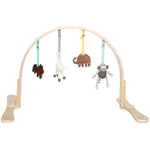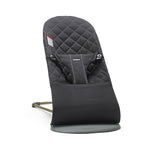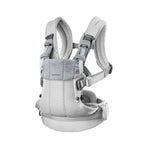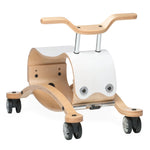Bumbleride works endlessly to provide a quality product with durability, safety and function, effortless maintenance, and the ability to reduce their impact on the environment. To ensure your stroller lasts beyond your family and stays out of landfills they have tested many different materials which have led them to use 100% recycled PET Oeko-Tex certified fabrics, TPR in their handles, a C6 DWR on their fabrics and a solution dye for our black colorways, which conserve water and energy.
Eco Materials
rPET: rPET is recycled polyethylene terephthalate (material for plastic bottles). Each single stroller fabric uses 28 plastic bottles that have been spun into polyester thread. Using rPET saves energy and water. Polyester: A synthetic fiber known for being durable, quick drying and offering strong color fade resistance. OEKO-TEX certified: Oeko-Tex is an independent product certification for all types of textiles tested for harmful substances. TPR: Thermoplastic Rubber, which is known for being durable, recyclable and taking little energy to produce. Bumbleride's handle grip material is made out of TPR and replaced their handle foam in 2012. DWR: DWR is Durable Water Repellent. Textiles that need to stand up to weather require a DWR treatment to help make them water resistant or waterproof. Bumbleride's fabrics are DWR treated for water resistants and to help prevent mold and stains. In 2018, they started using a C-6 treatment, which is more eco-friendly as its by-products break down faster in the environment with less potential toxicity to living things over time.
Bumbleride Maintenance
Fabric Maintenance: All Bumbleride strollers have removable seat fabric that can be machine-washed in cold water with mild detergent. To save time, they recommend spot washing when possible using either a basic detergent or dish soap and water solution. Wheel Maintenance: Bumbleride's air-filled tires are essentially small bicycle tires, very similar to what you would find on a child's bike. Each tire needs to be properly inflated to 25-30 PSI before use (not the 35 PSI max listed on the tire). If they are not inflated properly there is a chance they could puncture or become misaligned. They recommend checking and inflating tires every 1-2 weeks. Lubrication: The wheels, axles, and suspension all need regular cleaning and lubrication. They recommend adding drops near the hub and bearings of each wheel as well as on the back wheel axle where the suspension spring is housed.
Safety Tip
Wrist Strap: Always use the included wrist strap on hilly terrain or when going on a jog or fast-paced walk. Always be sure to apply the parking brake when stopped. Infant Mode: Make sure to connect the footrest area fabric to create a bassinet style seat
Get out and do what you love with the ride of your life!
















